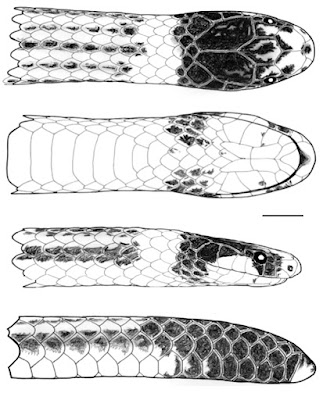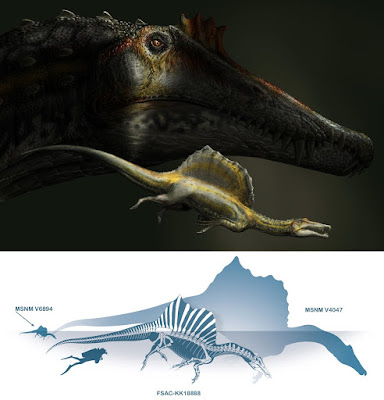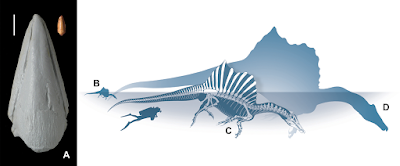[Most Recent Entries] [Calendar View]
Saturday, June 9th, 2018
| Time | Event | ||||
| 1:29p | [Herpetology • 2018] Apostolepis kikoi • A New Species of Burrowing Snake (Serpentes: Dipsadidae: Apostolepis) from the State of Mato Grosso, Central-West Region of Brazil
Abstract During a faunal rescue conducted at a hydroelectric power station constructed in a Cerrado savanna area in the state of Mato Grosso, a sample of five small stripe-patterned individuals of snakes of the genus Apostolepis Cope, 1862 document the existence of an undescribed species, which is named herein. The new species can be distinguished from its congeners by a combination of scale counts, number of maxillary teeth and color pattern. The new species is most similar to Apostolepis borellii Peracca, 1904, A. lineata Cope, 1887, A. nelsonjorgei Lema & Renner, 2004, A. nigroterminata Boulenger, 1896, A. serrana Lema & Renner, 2006 and A. underwoodi Lema & Campbell, 2017 in its coloration pattern. However, it is distinguished from these species by having a pair of triangular blotches covering portions of the third to sixth supralabials, a white nuchal collar, the shape of the fourth supralabial and the shape of the tip of tail, the number of supralabials in contact with parietals, the size of the anterior chinshields, the color pattern of the paraventral side, parietal and terminal scales, the width of dorsal stripes, and a distinct number of subcaudals. The new species occurs in areas within the Cerrado biome. Key words: Biodiversity, Cerrado, Chapada dos Guimarães, Elapomorphini, taxonomy Apostolepis kikoi sp. nov. Apostolepis sp. – Strüssmann 2000: 163. [Cresonymy] Apostolepis sp. 1 – Martins and Lema 2015: 102; Lema and Renner 2016: 71. [Cresonymy] Apostolepis sp. 3 – Martins and Lema 2015: 102 (partim). [Cresonymy] Apostolepis aff. borellii – Lema and Campbell 2017: 28 (partim). [Cresonymy] .... Etymology: The specific epithet honors Francisco Luís Franco (“Kiko”), a specialist in Brazilian snakes, as a tribute to his relentless friendship, dedication and enthusiasm as curator of Herpetological Collection Alphonse Richard Hoge of Instituto Butantan, São Paulo, Brazil (partially and tragically destroyed by fire on 15 May 2010). Fernanda Martins dos Santos, Omar Machado Entiauspe-Neto, Jailini da Silva Araújo, Moisés Barbosa de Souza, Thales de Lema, Christine Strussmann and Nelson Rufino de Albuquerque. 2018. A New Species of Burrowing Snake (Serpentes: Dipsadidae: Apostolepis) from the State of Mato Grosso, Central-West Region of Brazil. Zoologia. 35: 1-10. DOI: 10.3897/zoologia.35.e26742 | ||||
| 1:44p | [Botany • 2018] Pitcairnia robert-downsii • A Multivariate Analysis of the Pitcairnia palmeri group (Bromeliaceae: Pitcairnioideae)
Abstract A multivariate analysis of the Pitcairnia palmeri group are presented. Principal Components and Cluster analyses were performed in order to have more accurate information to delimit the species. The analyses showed that the specimens referred to Pitcairnia palmeri var. longebracteata are clearly delimited, while those identified as P. palmeri var. palmeri, P. colimensis, and P. compostelae have a greater overlap of morphological characters, but remain as separate entities. A discriminant analysis showed that morphological characters used have significant multivariate differences between the taxa (P < 0.0005), and that the most important variables in the differentiation of these taxa are the percentage of floral bracts that exceeds the length of the sepals, the length of the floral bracts, and the length of the peduncle. We conclude that P. palmeri var. longebracteata is clearly a different species, not a variety, therefore is described and illustrated as Pitcairnia robert-downsii, and that P. palmeri, P. compostelae and P. colimensis maintain their taxonomic status. Keywords: Durango, Pitcairnia, Monocots
Pitcairnia robert-downsii González-Rocha, Espejo, López-Ferr. & M. Castillo, stat. et nom. nov. Pitcairnia palmeri var. longebracteata L.B. Sm., syn. nov., Wrightia 2: 64. 1960, Type: MEXICO. Durango: Municipio de Pueblo Nuevo, 15–17 miles northeast of Palmito along highway from Mazatlán to Durango, 7000–7500 ft, pine-oak forest, June 16, 1951 (fl), H.S. Gentry & C.L. Gilly 10625 (holotype LL!). The new species differs from Pitcairnia palmeri by its longer peduncle bracts (5.3‒11.2 cm long vs. 1.3‒8.6 cm), by the length of its floral bracts (1.5‒5.8 cm vs. 0.4‒2.8 cm), by its densely white-lepidote leaves (vs. scarcely lepidote), by the number of flowers per inflorescence (19‒30 vs. 3‒21) and by its polystichously (vs. secund) flowers. .... Etymology:— The specific epithet honors the American botanist Robert Jack Downs (1923-2015), who, in collaboration with Lyman B. Smith, published the monograph of the Bromeliaceae for the Flora Neotropica. For his essential contribution to the studies in Bromeliaceae. Distribution, habitat and phenology:— Pitcairnia robert-downsii is only known from the state of Durango, in the municipality of Pueblo Nuevo (Fig. 5). It grows on cliffs or rocky slopes in pine-oak forests, at elevations between 1900 and 2500 m. It flowers from May to July. Edith González-Rocha, Manuel Arnoldo Castillo-Rivera, Ana Rosa López-Ferrari and Adolfo Espejo-Serna. 2018. A Multivariate Analysis of the Pitcairnia palmeri group (Bromeliaceae: Pitcairnioideae). Phytotaxa. 351(3); 219–228. DOI: 10.11646/phytotaxa.351.3.3 Resumen: Se presenta un análisis multivariado del grupo de Pitcairnia palmeri. Se realizaron análisis de componentes principales y de conglomerados con el propósito de obtener información más precisa para delimitar las especies. Dichos análisis mostraron que los especímenes referidos a Pitcairnia palmeri var. longebracteata están claramente delimitados, en tanto que los identificados como P. palmeri var. palmeri, P. colimensis y P. compostelae presentan una mayor superposición en sus caracteres morfológicos, aunque se mantienen como entidades separadas. Un análisis de discriminantes mostró que los caracteres morfológicos utilizados presentan diferencias significativas entre los taxa (P < 0.0005), y que las variables más importantes para diferenciarlos son el porcentaje de brácteas florales que sobrepasan el tamaño de los sépalos, el largo de las brácteas florales y el del pedúnculo. Se concluye que P. palmeri var. longebracteata es claramente una especie diferente, no una variedad, por lo que se describe e ilustra Pitcairnia robert-downsii y que P. palmeri, P. compostelae y P. colimensis mantienen su estatus taxonómico. Palabras clave: Durango, Pitcairnia | ||||
| 1:57p | [Paleontology • 2018] The Smallest Biggest Theropod Dinosaur: A Tiny Pedal Ungual of A Juvenile Spinosaurus from the Cretaceous of Morocco
Abstract We describe a nearly complete pedal ungual phalanx, discovered in the Kem Kem Beds (Cenomanian) of Tafilalt region, south-eastern Morocco. The bone is symmetric, pointed, low, elongate, and almost flat ventrally in lateral aspect. This peculiar morphology allows to refer the specimen to the smallest known individual of the genus Spinosaurus. The bone belongs to an early juvenile individual and it is proportionally identical to the ungual of the third digit of a large partial skeleton recently found, suggesting an isometric growth for this part of the pes and the retention of peculiar locomotor adaptations—such as traversing soft substrates or paddling—during the entire lifespan. Systematic Palaeontology DINOSAURIA Owen, 1842 THEROPODA Marsh, 1881 SPINOSAURIDAE Stromer, 1915 SPINOSAURUS Stromer, 1915 cf. Spinosaurus aegyptiacus Stromer, 1915 MSNM V6894 strongly resembles the pedal ungual phalanges associated to diagnosable skeletal remains of specimen FSAC-KK18888, described by Ibrahim et al. (2014) and defined as the neotype of S. aegyptiacus. MSNM V6894 shares with FSAC-KK18888 the following diagnostic characters: pedal unguals with flat plantar surface; pedal unguals broader than deep with length almost four times of the proximal depth. The overall morphology, proportions, and pattern of furrows are also very similar (see “Description and comparisons”). Following Ibrahim et al. (2014) we refer the ungual MSNM V6894 to cf. S. aegyptiacus. The variability found in cervicodorsal vertebrae (Evers et al., 2015) and quadrates (Hendrickx, Mateus & Buffetaut, 2016) might indicate a higher diversity among the spinosaurid material from the Albian–Cenomanian of North Africa than previously recognized. This proportional and morphological diversity may be related to individual variability or sexual dimorphism, or it could be above the species level. However, taking into account the low number of the known specimens, their low degree of completeness, their apparently strict taxonomic affinities, their occurrence in the same strata (or, more often, their uncertain stratigraphic provenance), and all the difficulties and controversies in investigating these aspects and, ultimately, in defining a species in palaeontology, we prefer to regard all the spinosaurid material (including pedal unguals) from the Kem Kem Beds as belonging to cf. S. aegyptiacus, pending more complete, articulated remains and reliable geological data. Further comments on this topic are beyond the purpose of this paper. Locality: MSNM V6894 comes from some kilometers south of Erfoud, between the villages of Taouz and Begaa, Errachidia Province, Morocco (Fig. 1). Horizon: Kem Kem Beds, Cenomanian, Upper Cretaceous (Sereno et al., 1996). The specimen was collected by G. Pasini (2008, personal communication) together with rostral teeth of the Aptian–Cenomanian elasmobranch Onchopristis sp. (Rage & Cappetta, 2002; Russell, 1996). Conclusion The specimen described here improves the knowledge about the appendicular skeleton of the spinosaurid theropods from the Kem Kem Beds (Late Cretaceous of Morocco) published by Ibrahim et al. (2014). The new material indicates that the pedal ungual phalanges of Spinosaurus grew with isometry and it documents the smallest individual referable to Spinosaurus, a genus/taxon usually indicated as the longest if not the largest theropod dinosaur (Dal Sasso et al., 2005). The specimen FSAC-KK18888, with an estimated body length of 11 m, has an ungual phalanx of digit III that is 130 mm long. Assuming isometry—although isometrical scaling of the other parts of the spinosaur hind limb skeleton shown in Fig. 3 must be considered as tentative—the 21 mm long ungual MSNM V6894 would pertain to an early juvenile individual, 1.78 m long (Figs. 3B–3D), that is half the estimated length of the smallest Spinosaurus published up to date, represented by the isolated quadrate MNHN KK374 (Hendrickx, Mateus & Buffetaut, 2016). According to Ibrahim et al. (2014), the unguals in Spinosaurus are reminiscent of the flattened pedal unguals of shorebirds that do not perch (Manegold, 2006), and the whole foot may have been adapted to traversing soft substrates or webbed for paddling. We agree with this hypothesis although it needs to be tested in the future based on more complete fossil remains and biomechanical analyses. The isolated tiny ungual here referred to a small, early juvenile of Spinosaurus indicates that the pes had the same locomotor adaptations observed in large individuals, that were probably achieved early in ontogeny and retained for the entire lifespan. Simone Maganuco and Cristiano Dal Sasso. 2018. The Smallest Biggest Theropod Dinosaur: A Tiny Pedal Ungual of A Juvenile Spinosaurus from the Cretaceous of Morocco. PeerJ. 6:e4785. DOI: 10.7717/peerj.4785 |
| << Previous Day |
2018/06/09 [Calendar] |
Next Day >> |
















